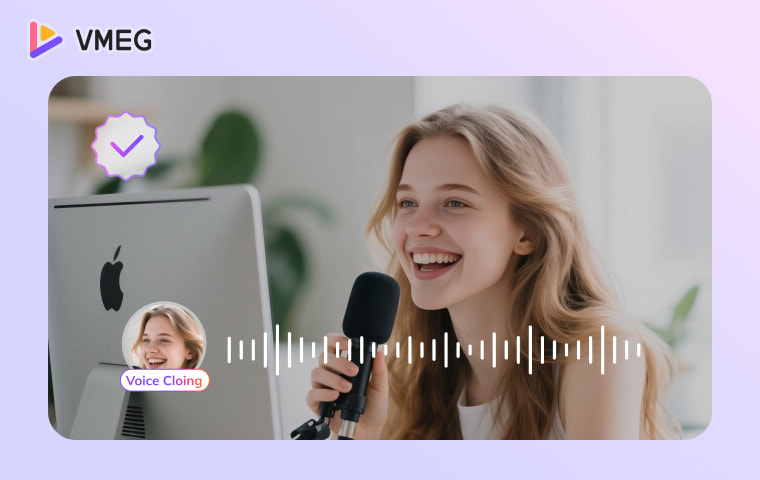
AI voice cloning uses machine learning to replicate human voices from audio samples. It has evolved from a specialized research project into a popular technology, now used in fields such as AI dubbing, content localization, accessibility tools, and entertainment.
In 2025, the most frequently googled question was "Is voice cloning legal?" What is the quick answer?
It depends on where you are, why you are using it, and whether you have permission.
This tutorial outlines global voice cloning legislation, typical ethical issues, and how to remain legal, as well as how platforms like VMEG AI promote responsible usage.
What is Voice Cloning?

Voice cloning is an AI technology that uses AI algorithms (often deep learning with text-to-speech models) to mimic a person’s real voice after analyzing a small audio sample.
Common legitimate applications include:
- Video localization entails translating and dubbing videos into multiple languages while retaining the original voice tone (VMEG AI shines here with 170+ languages and 7,000+ voices).
- Accessibility: Creating unique screen-reader voices.
- Entertainment - Recording voices for games, animation, and film dubbing.
- Customer service - Creating a consistent brand voice for virtual assistants.
Risks emerge when technology is utilized without permission, such as impersonating someone for fraud, political misinformation, or illicit commercial benefit.
Is Voice Cloning Legal? The Three Core Principles
Here are three key pillars — Consent, Purpose, and Jurisdiction, aroundwhich voice cloning laws are built.
Consent & Privacy
Let's talk about “voice” first: everyone's voice carries a unique label, just like a fingerprint. Without the person's consent, copying and pasting their voice is no joke—it could easily violate privacy, and in some places, it is even considered a violation of personal rights or biological information protection.
- Using it without permission. Secretly record your voice, then using it to generate AI speech and spreading it online. Once the party involved discovers this, court summonses and regulatory fines may follow.
- Being deceptive and not telling the truthIf it’s AI-generated speech from your own company but you don’t label it, leading people to mistakenly believe it’s a real person, consumer protection laws and data protection laws will quickly teach you a lesson.
Purpose & Potential Misuse
Let's talk about what it's used for—different uses lead to vastly different consequences:
- For educational purposes, pranks, or pure entertainment, you might be able to get away with it.
- But if you use it for defamation or slander, such as fabricating a “recording” of a celebrity “swearing,” you'll be facing a defamation lawsuit.
- Even worse is fraud: scammers use your voice to call family and friends, saying, “Help me transfer some money” or “Tell me the verification code,” and once they succeed, a criminal record is inevitable.
- Some people think “parody” is a free pass? Don't be naive; commercial use generally doesn't qualify for “fair use.”
Jurisdiction & Applicable Laws
Finally, the rules vary by country:
- In the US, many states (like California and New York) protect names, faces, and voices under “publicity rights,” so don't even think about using them for ads without permission.
- In the EU, the General Data Protection Regulation (GDPR) directly classifies voiceprints as sensitive personal data. Want to use them? Get a clear “I consent” first.
- Some places (like California) take it further: using AI-generated fake audio to mislead voters during an election? There’s specific legislation waiting to hold you accountable.
In summary: voice cloning sounds cool, but there are plenty of red lines. First, ask the person involved, then consider the intended use, and finally check local laws—otherwise, you might go from tech trendsetter to defendant in no time.
Legality and Ethical Considerations in Voice Cloning
Voice cloning is legal in specific, well-defined circumstances — most notably when there is documented consent, such as a signed contract or digital agreement.
Voice cloning also has a few “green channels”: using it for parody or satirical videos, as long as you don't cross the line, freedom of speech laws will generally protect you; reusing the voices of historical figures whose copyright has expired, once the copyright term expires, you can use them freely; and internal corporate training, as long as employees give prior consent and the scope of use is clearly defined, you usually won't run into any issues.
However, the practice becomes illegal when used without consent for commercial purposes, in fraudulent schemes, scams, or political misinformation campaigns, or when it violates privacy and data protection laws. Breaching non-disclosure agreements or talent contracts by cloning a protected voice can also result in serious legal consequences.
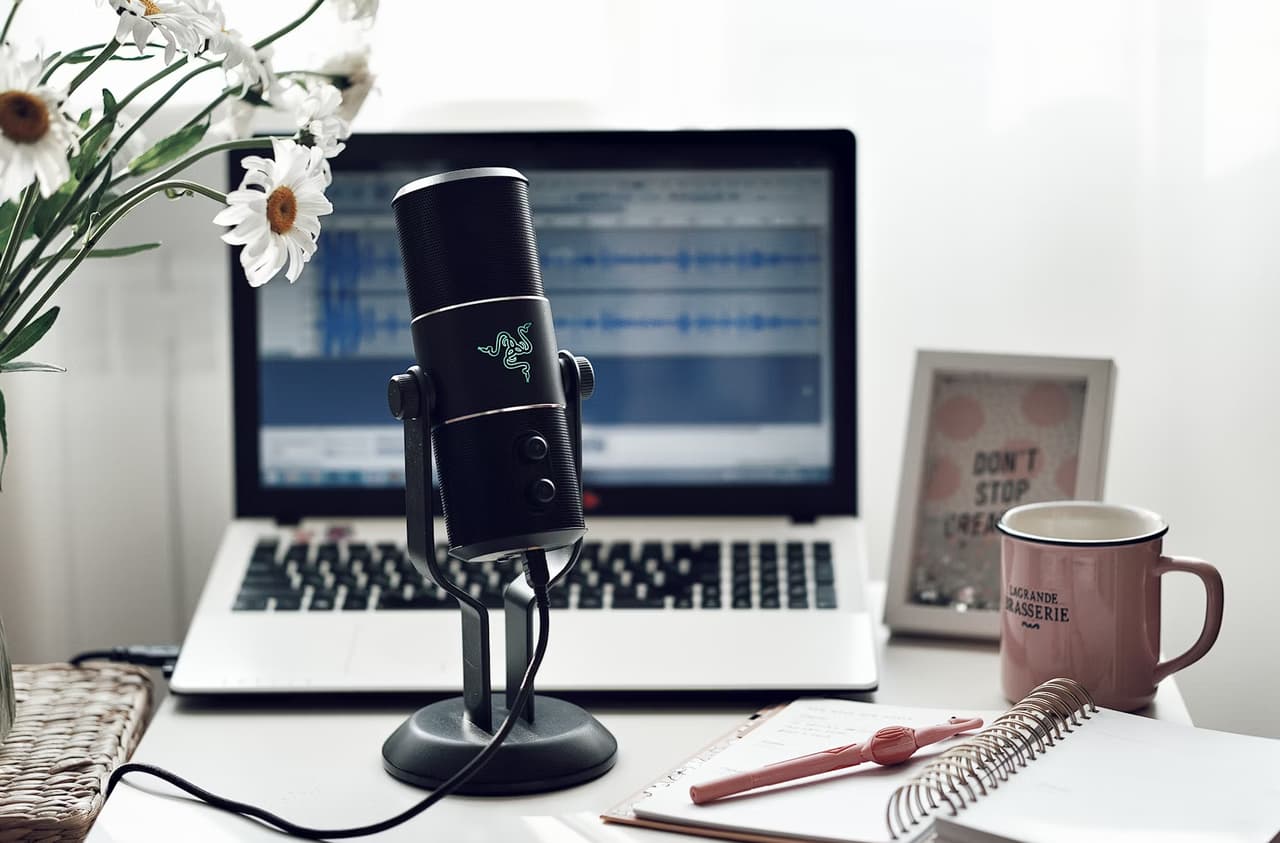
Even in situations where it is technically lawful, voice cloning raises important ethical considerations. The best ethical practice is to always disclose the use of AI-generated voices, clearly inform audiences, and give credit to the original voice talent whenever possible.
How to Stay Compliant:
Step 1. Get written consent – Always secure a signed contract or digital agreement from the voice owner to avoid legal disputes.
Step 2. Disclose AI usage – inform audiences and stakeholders when AI-generated voices are used to meet transparency laws and maintain trust.
Step 3. Avoid sensitive contexts – Do not use cloned voices in political, defamatory, or otherwise high-risk situations to reduce reputational damage.
Step 4. Use trusted AI platforms – Choose providers with strong data protection and consent management features to minimize security vulnerabilities.
How VMEG AI Enables Responsible Voice Cloning
VMEG AI is a professional AI video localization and dubbing platform designed to help creators, educators, businesses, and media companies scale their content globally while maintaining ethical and legal compliance. Operating in 179 countries, it combines cutting-edge speech synthesis with robust privacy safeguards to ensure that voice cloning is both high-quality and responsible.
Key Features for Responsible Voice Cloning:
- 170+ Languages and 7,000+ Realistic Voices – Enables highly accurate multilingual dubbing, with options to clone voices while retaining tone, style, and natural inflection.
- Multi-Speaker Dubbing – Accurately handles dialogues and group conversations, making it ideal for films, podcasts, and training content with multiple voices.
- Lip-Sync Alignment – Matches voice output to the speaker’s mouth movements for more natural viewing, crucial for localized video content.
- Consent-First Workflow – Built-in consent protocols ensure that voice samples cannot be cloned without documented permission from the voice owner.
- GDPR-Compliant Data Handling – All voice data is processed under strict privacy regulations, with encryption and secure storage.
- Post-Production Audio Controls – Allows fine-tuning of pitch, pacing, and emphasis for better quality control and authenticity.
- Non-Real-Time Processing – Voice cloning is processed offline rather than in live mode, reducing the risk of real-time impersonation misuse.
- Automatic Subtitles & Translation – Supports multilingual captions alongside dubbed audio to enhance accessibility and audience reach.
How to Use VMEG AI to Make Voice Cloning
Step 1. Sign in or create an account
Visit VMEG AI and log in to your account. New users can register for free to explore basic features. Go to the AI Audio Translator tool, select “Upload Media” to upload your original audio file in WAV, AAC, MP3, and M4A format, and at least 30 seconds long.
Visit VMEG AI and log in to your account. New users can register for free to explore basic features. Go to the AI Audio Translator tool, select “Upload Media” to upload your original audio file in WAV, AAC, MP3, and M4A format, and at least 30 seconds long.
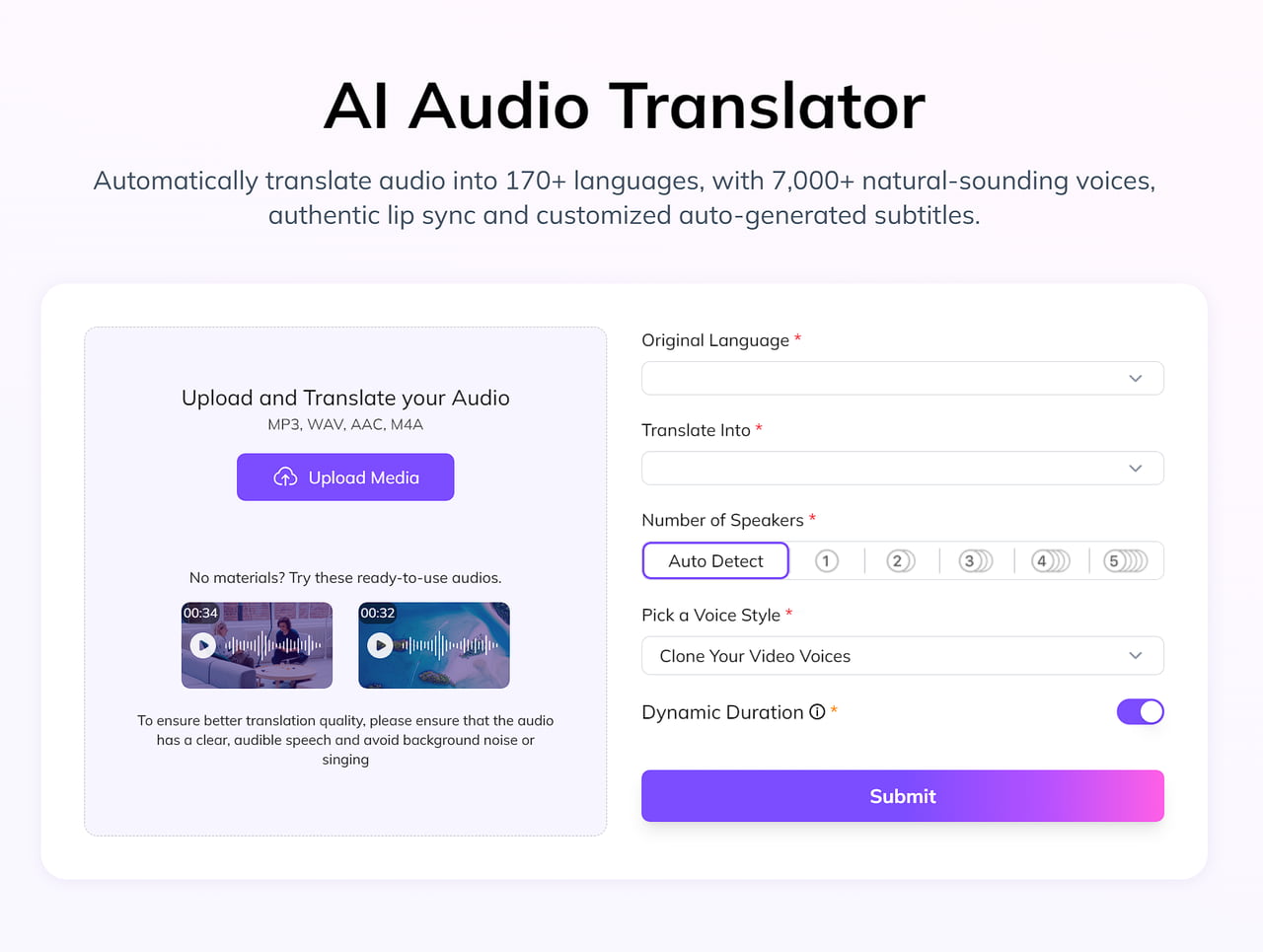
Step 2. Set language and output preferences
Choose from 170+ languages and 7,000+ voice styles. You can also adjust pitch, speed, tone, and emphasis to match your project needs.
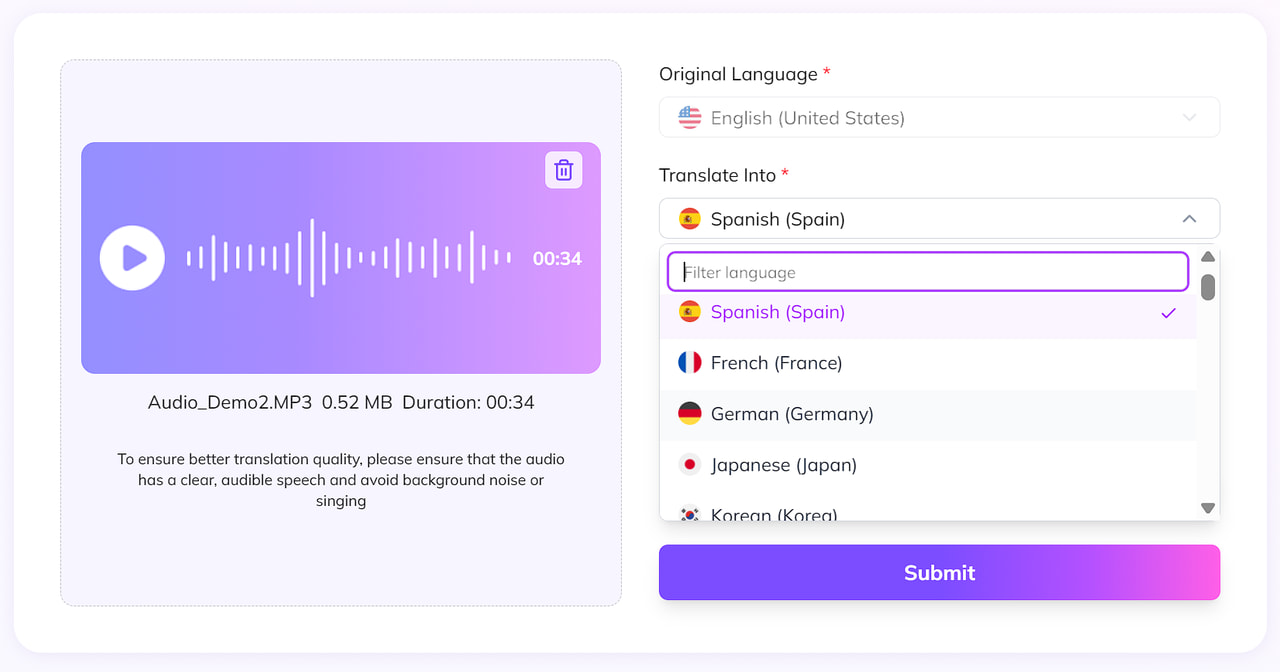
Step 3. Input or upload your script
Paste the text you want the cloned voice to speak, or upload a script file. For video dubbing, you can import your video and sync the audio automatically.
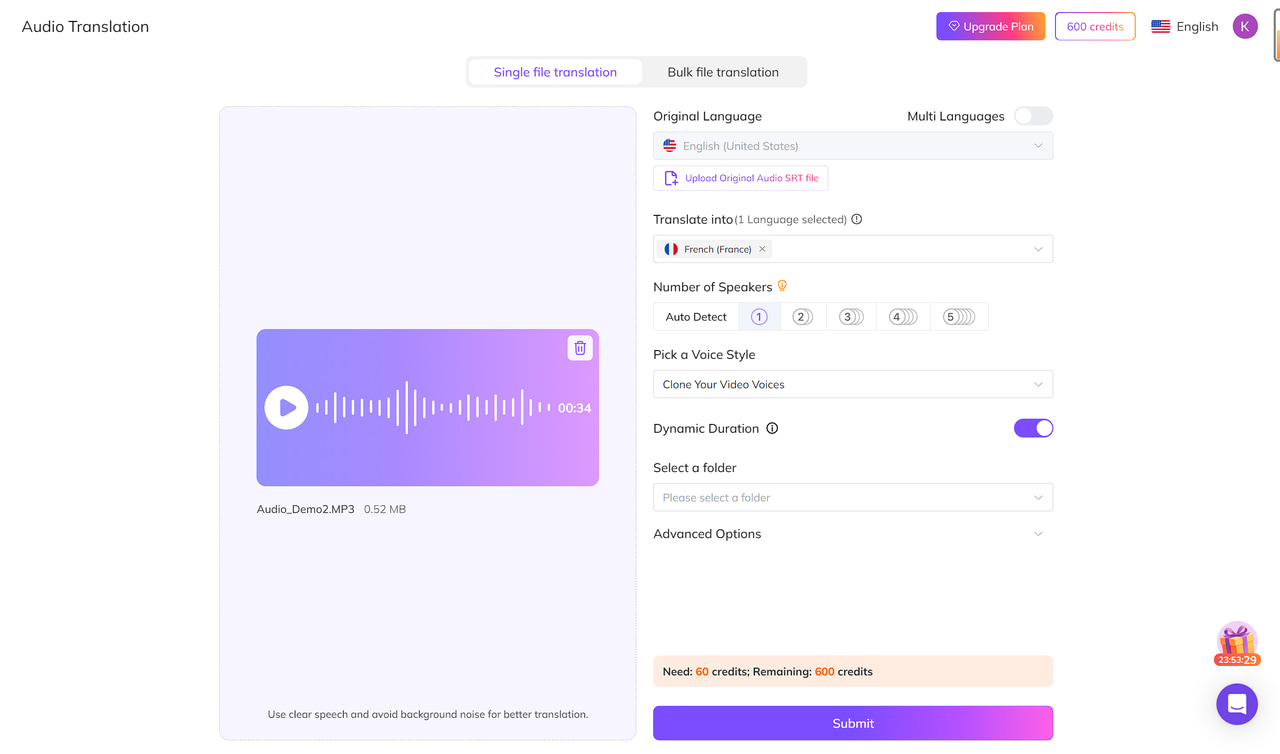
Step 4. Review and edit
Use VMEG AI’s built-in editor to check lip-sync alignment, audio clarity, and overall pacing. Make adjustments as needed for natural delivery.
Step 5. Export your final project
Once satisfied, export the audio or dubbed video in your preferred format. All projects are stored securely for future edits or downloads
FAQs
Q1. Is it legal to clone a celebrity’s voice for fun?
A1: In most places, yes for private use, but public/commercial release without consent may violate publicity rights.
Q2. Can I use AI to clone my own voice?
A2: Yes — this is the safest and most compliant scenario.
Q3. Do I have to disclose AI voice usage?
A3: Increasingly, yes — especially in the EU under the AI Act.
Q4. Are voice recordings copyrighted?
A4: In some jurisdictions, recorded performances have copyright protection; in others, only the underlying work does.
Conclusion
Voice cloning is neither fully legal nor fully illegal — context is everything. If you follow consent, transparency, and jurisdiction-specific laws, you can use it for innovative, ethical purposes such as video localization, accessibility, and entertainment.
Platforms like VMEG AI make compliance easier, enabling creators to scale globally without crossing legal lines.
VMEG Video Audio Translator
VMEG AI voice-cloning engine speaks every language on Earth. It instantly mirrors local accents, captures the full spectrum of human emotion, and preserves even the subtlest quirks of any speaker’s voice.
